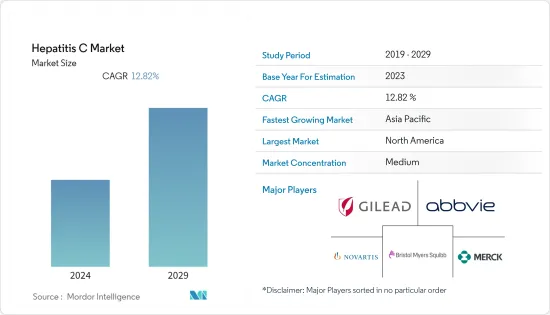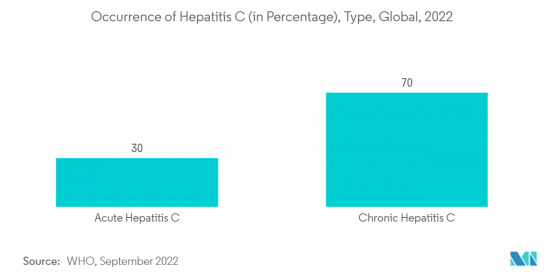Need help finding what you are looking for?
Contact Us
PUBLISHER: Mordor Intelligence | PRODUCT CODE: 1408270

PUBLISHER: Mordor Intelligence | PRODUCT CODE: 1408270
Hepatitis C - Market Share Analysis, Industry Trends & Statistics, Growth Forecasts 2024 - 2029
PUBLISHED:
PAGES: 120 Pages
DELIVERY TIME: 2-3 business days
SELECT AN OPTION

The hepatitis C market is poised to register a CAGR of 12.82% over the forecast period.
Key Highlights
- The COVID-19 pandemic significantly impacted the hepatitis C market and influenced the market growth rate during the pandemic phase. For instance, according to a study published by the Journal of Managed Care & Specialty Pharmacy in June 2022, patients with hepatitis C (HCV) had poorer access to treatment. They were much less likely to complete the treatment course amid the COVID-19 pandemic. The study observed decreased adherence to HCV DAA therapy and laboratory monitoring through the outbreak phase.
- Furthermore, the above study highlighted the telehealth option for patients in a post-COVID-19 environment that could provide an additional advantage in increasing access to care for patients with HCV. Hence, with better access to diagnosis and treatment post-COVID-19, the demand for hepatitis C tests and drugs observed a nominal increase. For instance, according to an article published by Inquiry in May 2023, the COVID-19 pandemic enhanced the use of telehealth to deliver services to those with hepatitis C virus (HCV), human immunodeficiency virus (HIV), and other chronic diseases in need of this type of care.
- Additionally, there was a post-pandemic acceptability of pharmacist-delivered telehealth services among HCV and HIV monoinfected and coinfected patients. Thus, as per the analysis, the impact of COVID-19 was severe in the initial stages of the outbreak; however, with increased awareness and growth in the accessibility of digital options such as telehealth in the post-pandemic era, the market is anticipated to witness stable growth over the coming years.
- Factors such as the growing disease burden of hepatitis C, increasing awareness and advances in diagnosis, and a surge in the availability of advanced therapeutic products are expected to drive market growth. For instance, according to the World Health Organization (WHO) update in June 2022, an estimated 58 million people had chronic hepatitis C virus infection, with about 1.5 million new infections occurring every year globally. An estimated 3.2 million adolescents and children had chronic hepatitis C infection. Thus, with a high burden of hepatitis C, the demand for its treatment and early diagnosis increases, leading to market growth.
- Furthermore, according to an article published by Current Opinion in Infectious Diseases, in July 2022, direct-acting antiviral (DAA) regimens targeting hepatitis C virus (HCV) were approved for young children. Postpartum treatment programs prevent vertical transmission but are hampered by low linkage rates to care and treatment completion. These challenges were avoided by DAA use in pregnancy. Thus, with the advancement in treatment modalities for hepatitis C, the demand for these is also expected to increase, driving market growth.
- Furthermore, May 2022 was observed as Hepatitis Awareness Month to raise awareness about, recognize the impact of, and decrease the stigma associated with viral hepatitis in the United States. Also, in September 2021, NACCHO partnered with NASTAD and the National Viral Hepatitis Roundtable to launch the Hepatitis Network for Education and Testing (HepNET) to identify and address the unmet needs of people who inject drugs (PWID) and improve their access to viral hepatitis education, prevention, testing, linkage to care, and treatment. Thus, with increasing awareness, the demand for hepatitis C diagnosis and treatment will likely increase, boosting market growth.
- Thus, all factors mentioned above are expected to boost market growth over the forecast period. However, the higher cost of treatment, social stigma, and undiagnosed cases are restraining the market growth.
Hepatitis C Market Trends
Antiviral Drugs Segment is Expected to Hold a Major Share in the Hepatitis C Market
- Antiviral drugs are one class of antimicrobials used for treating hepatitis C. These medications usually work by prohibiting the multiplication of the HCV virus. The segment's growth is attributed to the high burden of hepatitis C infection and the growing adoption and advantages of antiviral drugs over other treatment modalities.
- For instance, according to an article published by the American Association for the Study of Liver Diseases in September 2022, the estimated national prevalence rate of HCV infection in India was 0.32%, with 44.2 million HCV-positive individuals making up a significant portion of the worldwide HCV burden. Thus, with the high burden of hepatitis C, the demand for antiviral drugs is expected to increase, leading to segmental growth.
- Furthermore, according to the World Health Organization (WHO) update in June 2022, antiviral medicines cure more than 95% of hepatitis C infections. WHO recommends therapy with pan-genotypic direct-acting antivirals (DAAs) for all adults, adolescents, and children down to 3 years of age with chronic hepatitis C infection. In 2022, WHO included new recommendations for treating adolescents and children using the same pan-genotypic treatments for adults. Thus, with the increased adoption of antiviral therapies over other treatment modalities, the segment is anticipated to grow over the coming years.
- Thus, owing to the factors above, the usage of antiviral drugs is expected to grow significantly during the forecast period.

North America is Expected to Hold a Significant Share in the Hepatitis C Market
- Due to an increase in hepatitis C infections and the commercial availability of hepatitis drugs in the region, North America is expected to hold a significant market share in the hepatitis C market. For instance, according to an article published by the American Hospital Association, in August 2022, over 2 million United States adults have hepatitis C virus infection each year. Infections are increasing by about 60,000 annually due to the opioid epidemic. Thus, with an increase in hepatitis C infection, the demand for its diagnosis and treatment is likely to increase, ultimately boosting the market growth in the region.
- Furthermore, the presence of key market players, growing awareness programs, and the introduction of newer drugs and tests in the region bolster the market's growth in the North American region. For instance, in February 2022, the Task Force for Global Health sponsored a clinical trial to assess the outcomes of hepatitis C-affected mother-infant pairs exposed to direct-acting antivirals (DAAs) during pregnancy within a global clinical case registry. Additionally, in October 2021, AbbVie Inc. initiated a clinical trial in the United States to assess the adversative events and modifications in disease activity in adolescent and adult participants with acute hepatitis C virus (HCV) infection on treatment with oral tablets of Glecaprevir (GLE)/Pibrentasvir (PIB). Such instances are likely to favor the market growth in the region.
- Thus, due to the abovementioned factors, North America is anticipated to witness notable growth over the forecast period.
Hepatitis C Industry Overview
The hepatitis C market is moderately concentrated in nature due to the presence of companies operating globally and regionally. The competitive landscape includes analyzing companies, including Gilead Sciences, Inc., AbbVie Inc., Bristol-Myers Squibb Company, Merck & Co., Inc., and Novartis AG, among others.
Additional Benefits:
- The market estimate (ME) sheet in Excel format
- 3 months of analyst support
Product Code: 50000919
TABLE OF CONTENTS
1 INTRODUCTION
- 1.1 Study Assumptions and Market Definition
- 1.2 Scope of the Study
2 RESEARCH METHODOLOGY
3 EXECUTIVE SUMMARY
4 MARKET DYNAMICS
- 4.1 Market Overview
- 4.2 Market Drivers
- 4.2.1 Growing Disease Burden of Hepatitis C
- 4.2.2 Increasing Awareness and Advances in Diagnosis
- 4.2.3 Surge In Availability of Advanced Therapeutic Products
- 4.3 Market Restraints
- 4.3.1 High Cost of Treatment
- 4.3.2 Social Stigma and Undiagnosed Cases
- 4.4 Porter's Five Forces Analysis
- 4.4.1 Threat of New Entrants
- 4.4.2 Bargaining Power of Buyers/Consumers
- 4.4.3 Bargaining Power of Suppliers
- 4.4.4 Threat of Substitute Products
- 4.4.5 Intensity of Competitive Rivalry
5 MARKET SEGMENTATION (Market Size by Value - USD million)
- 5.1 By Type
- 5.1.1 Diagnosis
- 5.1.1.1 Liver Biopsy
- 5.1.1.2 Blood Tests
- 5.1.1.3 Other Diagnoses
- 5.1.2 Treatment
- 5.1.2.1 Antiviral Drugs
- 5.1.2.2 Immune Modulator Drugs
- 5.1.2.3 Other Treatments
- 5.1.1 Diagnosis
- 5.2 By End-User
- 5.2.1 Hospitals and Clinics
- 5.2.2 Diagnostic Laboratory
- 5.2.3 Other End-Users
- 5.3 Geography
- 5.3.1 North America
- 5.3.1.1 United States
- 5.3.1.2 Canada
- 5.3.1.3 Mexico
- 5.3.2 Europe
- 5.3.2.1 Germany
- 5.3.2.2 United Kingdom
- 5.3.2.3 France
- 5.3.2.4 Italy
- 5.3.2.5 Spain
- 5.3.2.6 Rest of Europe
- 5.3.3 Asia-Pacific
- 5.3.3.1 China
- 5.3.3.2 Japan
- 5.3.3.3 India
- 5.3.3.4 Australia
- 5.3.3.5 South Korea
- 5.3.3.6 Rest of Asia-Pacific
- 5.3.4 Middle East and Africa
- 5.3.4.1 GCC
- 5.3.4.2 South Africa
- 5.3.4.3 Rest of Middle East and Africa
- 5.3.5 South America
- 5.3.5.1 Brazil
- 5.3.5.2 Argentina
- 5.3.5.3 Rest of South America
- 5.3.1 North America
6 COMPETITIVE LANDSCAPE
- 6.1 Company Profiles
- 6.1.1 Gilead Sciences, Inc.
- 6.1.2 AbbVie Inc.
- 6.1.3 Bristol-Myers Squibb Company
- 6.1.4 Merck & Co., Inc.
- 6.1.5 Novartis AG
- 6.1.6 Johnson & Johnson
- 6.1.7 GlaxoSmithKline plc
- 6.1.8 F. Hoffmann-La Roche Ltd
- 6.1.9 Eli Lilly and Company
- 6.1.10 Takeda Pharmaceutical Company Limited
- 6.1.11 Cipla Inc.
- 6.1.12 Daiichi Sankyo Company, Limited
- 6.1.13 Astellas Pharma Inc.
7 MARKET OPPORTUNITIES AND FUTURE TRENDS
Have a question?


SELECT AN OPTION
Have a question?


Questions? Please give us a call or visit the contact form.
